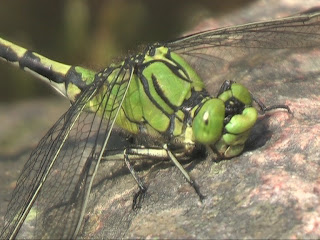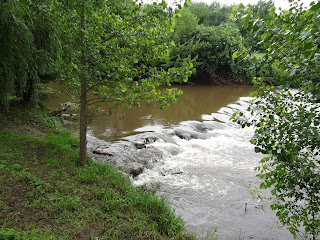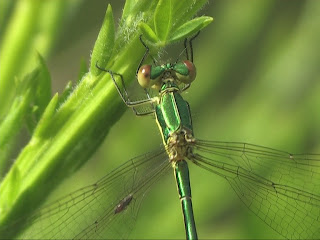Finland July 28th - August 4th 2012 Part 2
I spent the latter part of my week in Finland at two sites near Helsinki. Pikku Sorlampi is a small forest lake with spagnum moss margins and probably one of Helsinki's premier sites for odonata. The other key site I visited was Sarkkaniemi, a coastal site with brackish ponds and reeds.
Videograbs from my trip DVD. See Trip DVD's for sale.
Videograbs from my trip DVD. See Trip DVD's for sale.
 |
| Pikku Sorlampi |
Pikku Sorlampi is a great site for Siberian Hawker (Aeshna crenata), the largest of the European Hawkers.
 |
| Male Siberian Hawker Aeshna crenata |
The large size and all blue abdominal markings of the mature male make this species pretty easy to identify
 |
| Male Siberian Hawker Aeshna crenata |
The stem of the "T" mark on the frons is broad although I think this feature is pretty useless in the field.
Broad shoulder stripes and eye colour also help split this from other Hawkers,
 |
| Female Siberian Hawker Aeshna crenata |
The female has distinctive brown bands in the wings.
 |
| Female Siberian Hawker Aeshna crenata |
 |
| Male Dark (Eastern) White-faced Darter Leucorrhinia albifrons |
 |
| Male Dark (Eastern) White-faced Darter Leucorrhinia albifrons |
 |
| Female Dark (Eastern) White-faced Darter Leucorrhinia albifrons |
Dark (Eastern) White-faced Darter (Leucorrhinia albifrons) was present in large numbers at Pikku Sorlampi which was unexpected as they usually are at the end of their season by late July.
They have a close resemblance to Lillypad White-faced Darter (L. caudalis) but can be separated by the dark pterostigma, pale patches on the side of the labium (lower jaw), narrower abdomen and reduced blue prunosity on the upper abdomen.
Females are a little trickier but they have different abdominal markings and share feature of males in having pale patches on the labium which is helpful (although not visible in this picture)
 |
| Male Brilliant Emerald (Somatochlora metallica) |
Brilliant Emerald (Somatochlora metallica) was pretty common in Finland and reasonably numerous at Pikku Sorlampi. A difficult species to video as they rarely settled.
 |
| Male Downy Emerald Cordulia aenea |
 |
| Male Downy Emerald Cordulia aenea |
A couple of late Downy Emeralds (Cordulia aenea) were a surprise.
 |
| Male White-faced Darter Leucorrhinia dubia |
Species seen at Pikku Sorlampi:
3/8/12
Emerald Damselfly (Lestes sponsa) 50
Common Blue Damselfly (Enallagma cyathigerum) Common
Arctic Bluet (Coenagrion johanssoni) 1
Brown Hawker (Aeshna grandis) 2
Bog Hawker (Aeshna subarctica) 10
Siberian Hawker (Aeshna crenata) 8
Downy Emerald (Cordulia aenea) 5
Brilliant Emerald (Somatochlora metallica) 2
Four-spotted Chaser (Libellula quadrimaculata) 2
White-faced Darter (Leucorrhinia dubia) 10
Dark Whiteface (Leucorrhinia albifrons) 25
Black Darter (Sympetrum danae) 10
4/8/12
Emerald Damselfly (Lestes sponsa) Common
Common Blue Damselfly (Enallagma cyathigerum) Common
Variable Damselfly (Coenagrion pulchellum) 2
Brown Hawker (Aeshna grandis) 6
Common Hawker (Aeshna juncea) 6
Bog Hawker (Aeshna subarctica) 10
Siberian Hawker (Aeshna crenata) 10
Downy Emerald (Cordulia aenea) 2
Brilliant Emerald (Somatochlora metallica) 6
Yellow-spotted Emerald (Somatochlora flavomaculata) 1
Four-spotted Chaser (Libellula quadrimaculata) 2
White-faced Darter (Leucorrhinia dubia) 20
Dark Whiteface (Leucorrhinia albifrons) 40
Black Darter (Sympetrum danae) 20
Vagrant Darter [sp] (Sympetrum vulgatum) 2
The other key site I visited near Helsinki was Sarkkaniemi. The main target here was Baltic Hawker. I saw about 10 of these around a very brackish and stagnant pond. The males patrol the pond margins working in and out of the dense reed stems. You can hear them hitting the reed stems as they search for females. Unfortunately I was not able to video any females but did get this male.
 |
| Male Baltic Hawker Aeshna serrata/osiliensis |
 |
| Male Baltic Hawker Aeshna serrata/osiliensis |
The Baltic Hawker (Aeshna serrata) is very similar to Common Hawker (Aeshna juncea). The main identification features of Baltic Hawker are the narrower base of the "T" mark on the frons and the larger/more deeply blue abdominal spots.
Species seen on a late afternoon visit to Sarkkaniemi:
Emerald Damselfly (Lestes sponsa) 20
Azure Damselfly (Coenagrion puella) 3
Baltic Hawker (Aeshna serrata) 10
Yellow-winged Darter (Sympetrum flaveolum) 20
Vagrant Darter [sp] (Sympetrum vulgatum) 2
 |
| Yellow-winged Darter in tandem Sympetrum flaveolum |
 |
| Male Vagrant Darter Sympetrum vulgatum |
I thoroughly enjoyed my week in Finland and apart from an afternoon and a morning that rain stopped play, I was very lucky with the weather. My biggest disappointment was not getting footage of Arctic Bluet although I did see a few. I can see a return visit to Finland not being too far away.

























































